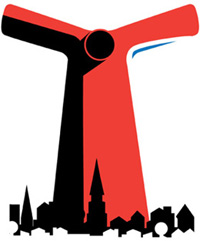Mythmaking

There is no doubt that the SPA, its expensive PR firm, and the mayor know how to frame an argument. But when it comes to the cruise ship tourism, does the frame fit?
“We are against jobs.” That’s the headline of the Charleston Mercury editorial that assails one prong of the SPA’s two-pronged (think “forked-tongue”) myth. The Mercury notes, “In his recent comments to Fox News, Bryon Miller, spokesman for the SPA, said that cruise ships bring jobs at a time when others are dissolving. Mr. Miller implies that those who want to reform the way cruise ships do business are going to reduce the number of jobs the cruise ships bring. No, sir, that is not true,” intoned the editorial. (2) But the facts haven’t slowed the SPA’s mythmaklng designed to fool the uninformed and gin up support from longshoremen’s union.
What’s the other half of that forked-tongue myth? “Their [“special interest” supporters of cruise ship regulation] goal is to cripple our port system to satisfy their anti-growth agenda. First it’s cruise ships, then cargo ships. Next it will be trucks and rails. They don’t seem to care that their agenda would irreparably damage economic development and kill jobs all across South Carolina.”(3) That statement, from SPA Chairman Bill Stern, is overreaching of the highest order. Oh, no, that wasn’t overreaching, his additional comment is overreaching: “It’s time for people of goodwill to stand against this narrow-minded band of radicals and their frivolous, irresponsible lawsuits.” But neither of these SPA protestations is true. No one wants to get rid of the cruise industry or eliminate a single job. No one is even commenting about cargo shipping in Charleston.
This is the big myth. Concerned citizens who want to regulate the size, number and frequency of cruise ship visits, or restrict the use of dangerous, foul bunker fuel air pollution while these ships are in port, also, according to this big myth, want to a) eliminate cruise ships and cruise jobs, and b) stop all port operations. This is nonsense. It’s bunk. It’s B.S. And if the mayor were playing for Charleston, he would be calling out the SPA for creating this codswallop. But he’s playing for the other team.
Which brings us to Hizzoner. This week, Charleston was placed on yet another “Watch List,” this time the 2012 World Monuments Fund “Watch List,” because of the rising number of cruise ships arriving in its harbor threatens “to undermine the very character that entices visitors to come to the town in the first place.”(4) The Post and Courier story adds that, “The listing calls global attention to Charleston’s cruise-ship debate — and how some feel the city considered the birthplace of the nation’s preservation movement is not doing enough to protect its future.”(5) Mayor Joseph Riley’s reaction was sadly predicable, “This group doesn’t know what they’re [sic] talking about.” Of course that would also mean that the National Trust for Historic Preservation doesn’t know either.
So let’s look at the statistic that both the mayor and SPA spokesman Bryan Miller repeat frequently, that only 3% of all tourists come via cruise ships. That figure assumes that there won’t be more cruises in the future, or that the ships won’t be larger in the future. This lovely status quo scenario is unlikely given that neither the SPA nor the mayor will codify [legally limit] either the size or number of cruise ship visits, and that’s why Charleston is now on two “Watch Lists.” But let’s assume that cruise ships visiting Charleston won’t be larger than 3,500 passengers. Consider this: 3,500 passengers disembarking at the same time (not counting the crew of at least 1,000) is the equivalent of 15 average-sized passenger jets unloading all at once, all in one place! Even the Charleston International Airport–with modern tourist facilities and full staff, a giant terminal and huge parking lots, away from the congestion and constraints of downtown–doesn’t have to deal with such an intense concentration of people. The other deliberately ignored corollary is that tourists coming by plane, train, or car come to Greater Charleston but then end up everywhere, from golf courses on Kiawah, to beaches on Sullivan’s Island, to downtown as well as James Island or Middleton Place.
Cruise ship tourists are unleashed, in concentrated throngs, all in one place and left to wash over downtown and an historic district that has neither the space nor the facilities to handle them.
So the logical thing would be to move the cruise terminal away from downtown, right? After all, no one would think of building a new airport downtown, and somehow, everyone flying into an airport gets to wherever they want to go. So you may be amazed that the SPA isn’t remotely interested in this solution. Read quotation from a July P&C article by David Slade: “In an acknowledgement that the plan is controversial and that opponents want few cruise ships or none at all operating from Union Pier, SPA President and CEO Jim Newsome said repeatedly that without the new passenger terminal there would be no Union Pier redevelopment. It’s an all-or-nothing deal, the way the SPA presents the plan. Either keep Union Pier as it is now, or embrace cruise ships and the new terminal.”(6) The SPA is the very definition of “compromise.”
“In 50 years, will we be honoring those who guided our cruise ship decisions of today, or will we be scrambling to change the names of public facilities and pulling down portraits and statues,” concludes the Mercury editorial. On this point, neither the current SPA officials nor the mayor will be revered in 50 years; maybe they don’t care.
–Jay
—
1) Preservation Society assessment of the Union Pier Terminal design
2) We are against Jobs – Mercury
3) Opponents of Cruise Tourism in Charleston sue Carnival – USA Today
4) World Monuments Fund – Charleston Historic District
